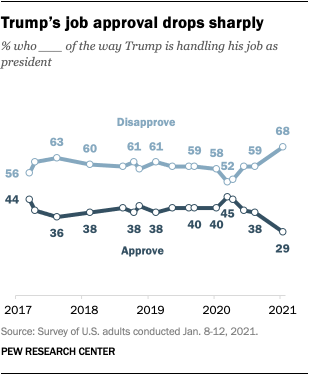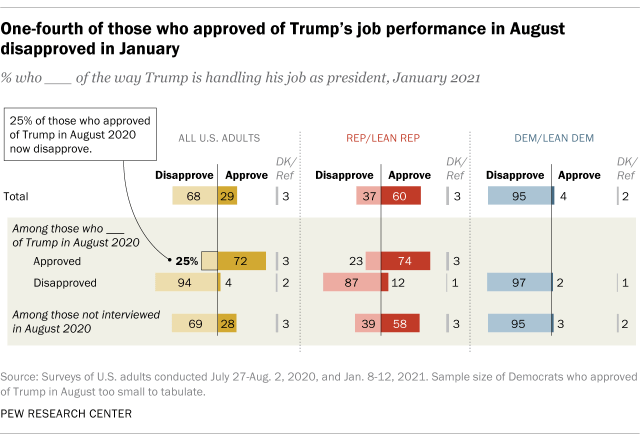Donald Trump’s final job approval rating as president was 29% in a Pew Research Center poll released last week, the lowest of his presidency and a 9 percentage point drop since August, when 38% of U.S. adults approved. The decrease stood out because even some of the momentous events of the past four years did not affect Trump’s approval rating very much.
So it was difficult to predict how the events of Jan. 6 – when rioters rampaged through the U.S. Capitol – might affect the public’s view of Trump in the Center’s survey, which was conducted in the days afterward. The 9-point fall in approval was the largest change between two Pew Research Center polls since Trump took office.
Most of the decline occurred among Republicans, the majority of whom were strongly supportive of Trump. How can we know that the change reflected a real shift in public opinion and was not an artifact of the poll itself, such as the possibility that some Republicans were less willing to be surveyed because of the events of Jan. 6?
This report is based on two surveys conducted with members of Pew Research Center’s American Trends Panel, one in July-August 2020 and the other in January 2021. Much of the analysis is based on a comparison of responses of 4,075 panelists who took both surveys. Here are the questions from the August survey (the presidential approval question and party affiliation measures are the same in August and January) and the methodology for the August survey and the January survey.
Differences between two polls – like our August 2020 and January 2021 surveys – can arise from some mix of two broad sources: real change in opinions, or differences in the sample of people included in each poll. If two surveys are made up of samples of different people, it can sometimes be hard to differentiate real change from differences in the composition of the two samples. But if the same people are interviewed at two points in time, and many give a different answer in the second survey than the first, we can know with near certainty that the change is real.
And that is the case with the Pew Research Center comparison, since it relies on repeated interviews with members of its American Trends Panel, a nationally representative panel of randomly selected U.S. adults. Most of those who participated in the January survey also had participated in the August survey, so for these panelists, we can compare their answers in the two interviews to see if they are the same or different.
Among the 4,075 panelists who responded to both surveys, 25% of those who approved of Trump’s job performance in August changed their answer to disapproval in January. The drop was concentrated among Republicans and Republican-leaning independents, since hardly any Democrats (and relatively few independents who do not lean to a party) approved of Trump’s job performance in August. Among Republicans and Republican-leaning independents who approved of Trump’s performance in August, 23% disapproved in January.
Not surprisingly, the drop-off in approval was more pronounced among those who were less enthusiastic about Trump in the August survey. For example, just 13% of approvers who said in August they would be “excited” by Trump’s reelection (as opposed to relieved, disappointed or angry) switched from approval to disapproval in January. Among Trump approvers who said they would be “relieved” by Trump’s reelection, 31% switched to disapproval in January.
Similarly, among approvers who rated Trump’s handling of the coronavirus outbreak as “excellent” in August, 12% shifted from approval to disapproval, compared with 35% among those who judged his handling of the pandemic as “good.”
But virtually equal shares of all of these groups took part in the January survey, so the overall decline in approval was not a result of a disproportionate decline in cooperation among the most enthusiastic Trump supporters. In fact, 91% of panelists who participated in the August survey and were sampled for the January survey completed the January interview, leaving little room for this type of error to creep in. More generally, there was no appreciable difference in the political makeup of those who took the two surveys.
Sizable shifts in public opinion like this are fairly rare, especially when the subject is well known and opinions have tended to be stable over time. Consequently, observers should be cautious when a survey shows a big change, such as the drop in Trump approval after the events of Jan. 6. However, the availability of data on the same respondents at two points in time allows us to distinguish between real change in opinion and something more illusory, such as differences in the samples of two polls.





